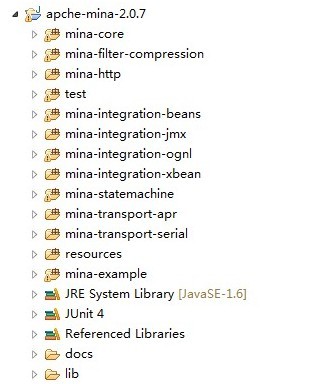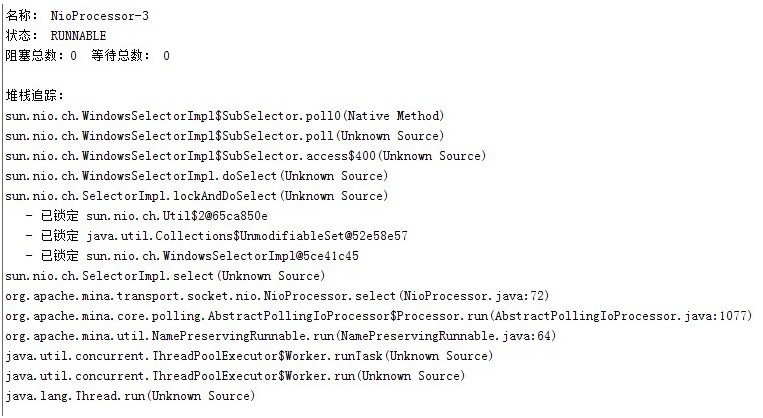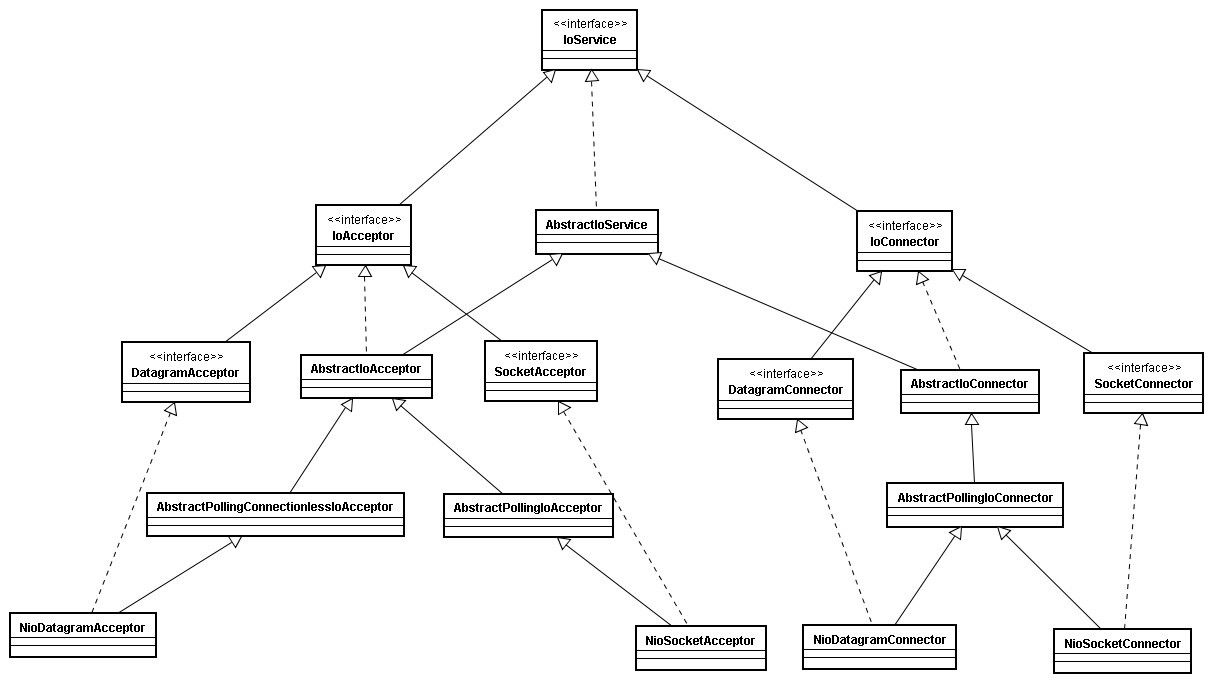-
1.源码包结构

2.测试线程
1.启动mina-example下echoserver#Main
2.启动jconsole查看线程:
1.NioSocketAcceptor
 Runnable为AbstractPollingIoAcceptor$Acceptor
Runnable为AbstractPollingIoAcceptor$Acceptor
3.启动com.game.landon.entrance.EchoClient,连接已启动的echoserver. ->此时查看线程->多了一个
2.NioProcessor

Runnable为AbstractPollingIoProcessor$Processor
4.两个线程池来源:
1.AbstractIoService(IoSessionConfig sessionConfig,Executor executor)
该构造函数中判断
if(executor == null){
this.executor = Executors.newCachedThreadPool();
}
详见源码.
2.SimpleIoProcessorPool
其构造函数判断同上
3.内部基本流程
1.SocketAcceptor acceptor = new NioSocketAcceptor();
1.初始化NioSocketAcceptor线程池 {@link AbstractIoService }
2.初始化NioProcessor线程池 {@link SimpleIoProcessorPool }
3. NioSocketAcceptor#init
初始化Selector:selector = Selector.open();
2.acceptor.bind(new InetSocketAddress(PORT));
1.AbstractPollingIoAcceptor#bindInternal
#startupAcceptor
- >NioSocketAcceptor线程池执行Acceptor这个任务.
 //1.startupAcceptor启动的时候也会判断是否已存在Acceptor这个任务,如果不存在才会创建.
//1.startupAcceptor启动的时候也会判断是否已存在Acceptor这个任务,如果不存在才会创建.
 // 2.Accetpor这个任务结束条件:所有bind的端口unbind->也会将Acceptor引用置为null.
// 2.Accetpor这个任务结束条件:所有bind的端口unbind->也会将Acceptor引用置为null.
 // 3.每个NioSocketAcceptor只有一个selector/且只对应一个Acceptor任务,即只有一个Acceptor线程.所以我们可以说Acceptor就是单线程的.(即便是一个CachedThreadPool)
// 3.每个NioSocketAcceptor只有一个selector/且只对应一个Acceptor任务,即只有一个Acceptor线程.所以我们可以说Acceptor就是单线程的.(即便是一个CachedThreadPool)
3.Acceptor#run
1.while(selectable)
1.selector.select
2.#registerHandles
->NioSocketAcceptor#open
设置socket选项并向selector注册OP_ACCEPT事件
3.#processHandles
1.NioSocketAcceptor#accept->返回NioSocketSession
2.SimpleIoProcessorPool#add
1.根据sessionId将session与pool中的某个NioProcessor绑定 {@link SimpleIoProcessorPool#getProcessor}
2.AbstractPollingIoProcessor#add
3. AbstractPollingIoProcessor#startupProcessor
->NioProcessor线程池执行Processor这个任务
 // 从这段代码看出:
// 从这段代码看出:
 //1.Processor这个任务只会创建一次.即每一个NioProcessor对象最多拥有一个Processor
//1.Processor这个任务只会创建一次.即每一个NioProcessor对象最多拥有一个Processor
 // 2.每个NioProcessor只会向线程池提交一次Processor任务.而Processor任务是一个无限循环的任务.
// 2.每个NioProcessor只会向线程池提交一次Processor任务.而Processor任务是一个无限循环的任务.
 // 也可以说,每个Processor就占据着线程池的一个线程.->即每个NioProcessor对象对应线程池中的一个线程
// 也可以说,每个Processor就占据着线程池的一个线程.->即每个NioProcessor对象对应线程池中的一个线程
 // 3.而session是与某个固定的NioProcessor绑定的(取模)->也就是说每个session的处理都是单线程的.(均在NioProcessor的唯一Processor线程执行)
// 3.而session是与某个固定的NioProcessor绑定的(取模)->也就是说每个session的处理都是单线程的.(均在NioProcessor的唯一Processor线程执行)
 // 4.public NioSocketAcceptor(int processorCount)构造中可指定processor的数目,其实最终是指定CacheThreadPool中多少用于prossor的线程数目.
// 4.public NioSocketAcceptor(int processorCount)构造中可指定processor的数目,其实最终是指定CacheThreadPool中多少用于prossor的线程数目.
//(默认:private static final int DEFAULT_SIZE = Runtime.getRuntime().availableProcessors() + 1)
// 5.每个NioProcessor中只有一个selector.

 private void startupProcessor()
private void startupProcessor()  {
{
 Processor processor = processorRef.get();
Processor processor = processorRef.get();


 if (processor == null)
if (processor == null)  {
{
 processor = new Processor();
processor = new Processor();


 if (processorRef.compareAndSet(null, processor))
if (processorRef.compareAndSet(null, processor))  {
{
 executor.execute(new NamePreservingRunnable(processor, threadName));
executor.execute(new NamePreservingRunnable(processor, threadName));
 }
}
 }
}

 // Just stop the select() and start it again, so that the processor
// Just stop the select() and start it again, so that the processor
 // can be activated immediately.
// can be activated immediately.
 wakeup();
wakeup();
 }
}

 /** *//**
/** *//**
 * This private class is used to accept incoming connection from
* This private class is used to accept incoming connection from
 * clients. It's an infinite loop, which can be stopped when all
* clients. It's an infinite loop, which can be stopped when all
 * the registered handles have been removed (unbound).
* the registered handles have been removed (unbound).
 */
*/
 private class Acceptor implements Runnable
private class Acceptor implements Runnable


 {
{
 public void run()
public void run()


 {
{
 int nHandles = 0;
int nHandles = 0;
 lastIdleCheckTime = System.currentTimeMillis();
lastIdleCheckTime = System.currentTimeMillis();

 // Release the lock
// Release the lock
 lock.release();
lock.release();

 while ( selectable )
while ( selectable )


 {
{
 try
try


 {
{
 int selected = select( SELECT_TIMEOUT );
int selected = select( SELECT_TIMEOUT );

 nHandles += registerHandles();
nHandles += registerHandles();

 if ( nHandles == 0 )
if ( nHandles == 0 )


 {
{
 try
try


 {
{
 lock.acquire();
lock.acquire();

 if ( registerQueue.isEmpty() && cancelQueue.isEmpty() )
if ( registerQueue.isEmpty() && cancelQueue.isEmpty() )


 {
{
 acceptor = null;
acceptor = null;
 break;
break;
 }
}
 }
}
 finally
finally


 {
{
 lock.release();
lock.release();
 }
}
 }
}

 if ( selected > 0 )
if ( selected > 0 )


 {
{
 processReadySessions( selectedHandles() );
processReadySessions( selectedHandles() );
 }
}

 long currentTime = System.currentTimeMillis();
long currentTime = System.currentTimeMillis();
 flushSessions( currentTime );
flushSessions( currentTime );
 nHandles -= unregisterHandles();
nHandles -= unregisterHandles();

 notifyIdleSessions( currentTime );
notifyIdleSessions( currentTime );
 }
}
 catch ( ClosedSelectorException cse )
catch ( ClosedSelectorException cse )


 {
{
 // If the selector has been closed, we can exit the loop
// If the selector has been closed, we can exit the loop
 break;
break;
 }
}
 catch ( Exception e )
catch ( Exception e )


 {
{
 ExceptionMonitor.getInstance().exceptionCaught( e );
ExceptionMonitor.getInstance().exceptionCaught( e );

 try
try


 {
{
 Thread.sleep( 1000 );
Thread.sleep( 1000 );
 }
}
 catch ( InterruptedException e1 )
catch ( InterruptedException e1 )


 {
{
 }
}
 }
}
 }
}

 if ( selectable && isDisposing() )
if ( selectable && isDisposing() )


 {
{
 selectable = false;
selectable = false;
 try
try


 {
{
 destroy();
destroy();
 }
}
 catch ( Exception e )
catch ( Exception e )


 {
{
 ExceptionMonitor.getInstance().exceptionCaught( e );
ExceptionMonitor.getInstance().exceptionCaught( e );
 }
}
 finally
finally


 {
{
 disposalFuture.setValue( true );
disposalFuture.setValue( true );
 }
}
 }
}
 }
}
 }
}
2.Processor#run
1.for(;;)
1.select(SELECT_TIMEOUT)
2.#handleNewSessions
1. AbstractPollingIoProcessor#addNow
2. AbstractPollingIoProcessor#init
NioProcessor#init->session.getChannel向selector注册OP_READ事件
3.#updateTrafficmask
4.#process
//process reads/process writes
5.#flush
6.#nofifyIdleSessions

 /** *//**
/** *//**
 * The main loop. This is the place in charge to poll the Selector, and to
* The main loop. This is the place in charge to poll the Selector, and to
 * process the active sessions. It's done in
* process the active sessions. It's done in
 * - handle the newly created sessions
* - handle the newly created sessions
 * -
* -
 */
*/

 private class Processor implements Runnable
private class Processor implements Runnable  {
{

 public void run()
public void run()  {
{
 assert (processorRef.get() == this);
assert (processorRef.get() == this);

 int nSessions = 0;
int nSessions = 0;
 lastIdleCheckTime = System.currentTimeMillis();
lastIdleCheckTime = System.currentTimeMillis();


 for (;;)
for (;;)  {
{

 try
try  {
{
 // This select has a timeout so that we can manage
// This select has a timeout so that we can manage
 // idle session when we get out of the select every
// idle session when we get out of the select every
 // second. (note : this is a hack to avoid creating
// second. (note : this is a hack to avoid creating
 // a dedicated thread).
// a dedicated thread).
 long t0 = System.currentTimeMillis();
long t0 = System.currentTimeMillis();
 int selected = select(SELECT_TIMEOUT);
int selected = select(SELECT_TIMEOUT);
 long t1 = System.currentTimeMillis();
long t1 = System.currentTimeMillis();
 long delta = (t1 - t0);
long delta = (t1 - t0);


 if ((selected == 0) && !wakeupCalled.get() && (delta < 100))
if ((selected == 0) && !wakeupCalled.get() && (delta < 100))  {
{
 // Last chance : the select() may have been
// Last chance : the select() may have been
 // interrupted because we have had an closed channel.
// interrupted because we have had an closed channel.

 if (isBrokenConnection())
if (isBrokenConnection())  {
{
 LOG.warn("Broken connection");
LOG.warn("Broken connection");

 // we can reselect immediately
// we can reselect immediately
 // set back the flag to false
// set back the flag to false
 wakeupCalled.getAndSet(false);
wakeupCalled.getAndSet(false);

 continue;
continue;

 } else
} else  {
{
 LOG.warn("Create a new selector. Selected is 0, delta = " + (t1 - t0));
LOG.warn("Create a new selector. Selected is 0, delta = " + (t1 - t0));
 // Ok, we are hit by the nasty epoll
// Ok, we are hit by the nasty epoll
 // spinning.
// spinning.
 // Basically, there is a race condition
// Basically, there is a race condition
 // which causes a closing file descriptor not to be
// which causes a closing file descriptor not to be
 // considered as available as a selected channel, but
// considered as available as a selected channel, but
 // it stopped the select. The next time we will
// it stopped the select. The next time we will
 // call select(), it will exit immediately for the same
// call select(), it will exit immediately for the same
 // reason, and do so forever, consuming 100%
// reason, and do so forever, consuming 100%
 // CPU.
// CPU.
 // We have to destroy the selector, and
// We have to destroy the selector, and
 // register all the socket on a new one.
// register all the socket on a new one.
 registerNewSelector();
registerNewSelector();
 }
}

 // Set back the flag to false
// Set back the flag to false
 wakeupCalled.getAndSet(false);
wakeupCalled.getAndSet(false);

 // and continue the loop
// and continue the loop
 continue;
continue;
 }
}

 // Manage newly created session first
// Manage newly created session first
 nSessions += handleNewSessions();
nSessions += handleNewSessions();

 updateTrafficMask();
updateTrafficMask();

 // Now, if we have had some incoming or outgoing events,
// Now, if we have had some incoming or outgoing events,
 // deal with them
// deal with them

 if (selected > 0)
if (selected > 0)  {
{
 //LOG.debug("Processing
//LOG.debug("Processing  "); // This log hurts one of the MDCFilter test
"); // This log hurts one of the MDCFilter test
 process();
process();
 }
}

 // Write the pending requests
// Write the pending requests
 long currentTime = System.currentTimeMillis();
long currentTime = System.currentTimeMillis();
 flush(currentTime);
flush(currentTime);

 // And manage removed sessions
// And manage removed sessions
 nSessions -= removeSessions();
nSessions -= removeSessions();

 // Last, not least, send Idle events to the idle sessions
// Last, not least, send Idle events to the idle sessions
 notifyIdleSessions(currentTime);
notifyIdleSessions(currentTime);

 // Get a chance to exit the infinite loop if there are no
// Get a chance to exit the infinite loop if there are no
 // more sessions on this Processor
// more sessions on this Processor

 if (nSessions == 0)
if (nSessions == 0)  {
{
 processorRef.set(null);
processorRef.set(null);


 if (newSessions.isEmpty() && isSelectorEmpty())
if (newSessions.isEmpty() && isSelectorEmpty())  {
{
 // newSessions.add() precedes startupProcessor
// newSessions.add() precedes startupProcessor
 assert (processorRef.get() != this);
assert (processorRef.get() != this);
 break;
break;
 }
}

 assert (processorRef.get() != this);
assert (processorRef.get() != this);


 if (!processorRef.compareAndSet(null, this))
if (!processorRef.compareAndSet(null, this))  {
{
 // startupProcessor won race, so must exit processor
// startupProcessor won race, so must exit processor
 assert (processorRef.get() != this);
assert (processorRef.get() != this);
 break;
break;
 }
}

 assert (processorRef.get() == this);
assert (processorRef.get() == this);
 }
}

 // Disconnect all sessions immediately if disposal has been
// Disconnect all sessions immediately if disposal has been
 // requested so that we exit this loop eventually.
// requested so that we exit this loop eventually.

 if (isDisposing())
if (isDisposing())  {
{

 for (Iterator<S> i = allSessions(); i.hasNext();)
for (Iterator<S> i = allSessions(); i.hasNext();)  {
{
 scheduleRemove(i.next());
scheduleRemove(i.next());
 }
}

 wakeup();
wakeup();
 }
}

 } catch (ClosedSelectorException cse)
} catch (ClosedSelectorException cse)  {
{
 // If the selector has been closed, we can exit the loop
// If the selector has been closed, we can exit the loop
 break;
break;

 } catch (Throwable t)
} catch (Throwable t)  {
{
 ExceptionMonitor.getInstance().exceptionCaught(t);
ExceptionMonitor.getInstance().exceptionCaught(t);


 try
try  {
{
 Thread.sleep(1000);
Thread.sleep(1000);

 } catch (InterruptedException e1)
} catch (InterruptedException e1)  {
{
 ExceptionMonitor.getInstance().exceptionCaught(e1);
ExceptionMonitor.getInstance().exceptionCaught(e1);
 }
}
 }
}
 }
}


 try
try  {
{

 synchronized (disposalLock)
synchronized (disposalLock)  {
{

 if (disposing)
if (disposing)  {
{
 doDispose();
doDispose();
 }
}
 }
}

 } catch (Throwable t)
} catch (Throwable t)  {
{
 ExceptionMonitor.getInstance().exceptionCaught(t);
ExceptionMonitor.getInstance().exceptionCaught(t);

 } finally
} finally  {
{
 disposalFuture.setValue(true);
disposalFuture.setValue(true);
 }
}
 }
}
 }
}
4.相关类图关系
1.IoService关系类图
2.IoProcessor关系类图

3.IoSession关系类图

5.总结:
本篇只是引入篇,着重介绍了mina2内部的两个acceptor线程池和processor线程池.关于nio相关请看我之前的文章.
http://www.blogjava.net/landon/archive/2013/08/16/402947.html
posted on 2013-11-18 17:24
landon 阅读(2075)
评论(2) 编辑 收藏 所属分类:
Sources